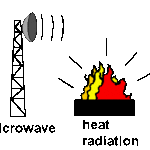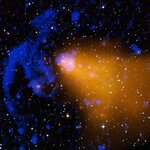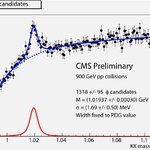Physics

This is to inform you of the new luminosity record set today by the Tevatron collider at Fermilab. The machine has been working excellently, improving its performance as the machinists found ways to obtain higher stacks of antiprotons, reducing inefficiencies in the transport of the beams from one accelerator to the other in the injection process, or finding better beam tunes. A painstaking work that brought increasing returns, it seems.
Instantaneous luminosity is a measure of the number of collisions of the colliding beams. It basically depends on the number of particles contained in "…

http://arxiv.org/PS_cache/arxiv/pdf/1002/1002.3425v1.pdf
We should depart from notion of a continuously existing electron and consider an elementary particle an ensemble of events connected by probability. It’s like the fact that physical particle exists only at the instant when it is involved in some event. A particle doesn’t exist in any other time, but there’s a probability that something will happen to it. Thus, if nothing happens with the particle between the event of creating it and the event of detectiting it the behavior of the particle is the behavior of probability between…

Synchrotron Radiation
Synchrotron radiation is a kind of electromagnetic radiation caused by the high energy particles (with a velocity close to the speed of light). Radiation is very common in daily life, by which the light, heat, sound and many other electromagnetic waves transmitted to all directions from the source, as shown in Fig. 1 [1]. Here the synchrotron radiation will be introduced in details.
Fig. 1 Radiations of the electromagnetic waves
1. What is the synchrotron?
Synchrotron is designed based on the interaction of the charged particles with applied magnetic field and…

I was invited to give a talk and participate in a round table, at a conference on Physics communication in Frascati, a small town near Rome where the Italian Institute of Nuclear Physics has its headquarters. The conference also has a poster session, so I produced a simple poster to advertise this site.
Here is the poster (in italian -sorry). The full-sized version is 10 Mbytes so I will avoid posting it here.
Below is a quick-and-dirty translation of what I write in a few of the frames:
Basic research must not continue ignoring the need to take part in scientific outreach. There exists a…

Two new studies made using NASA's Chandra X-ray Observatory have put Einstein's General Theory of Relativity to the test (again) and the results show it is still the best game in town.
Each team used observations of galaxy clusters, the largest objects in the Universe bound together by gravity, and one result undercuts a rival gravity model to General Relativity, known as "f(R) gravity", while the other shows that Einstein's theory works over a vast range of times and distances across the cosmos.
In recent years, physicists have turned their attention to competing theories to General…

I am quite proud today to announce the publication of a new physics result from the CMS experiment: maybe not a groundbreaking result, yet one to which I contributed directly, and the first full-fledged analysis of CMS collider data brought to public domain by the group of Padova researchers to which I belong.
Two words on the CMS-Padova group
The group of physicists in Padova who are members of the CMS collaboration is quite large: in fact, it is the third-largest in CMS, and the largest University group, counting about 70 CMS collaborators (I believe we beat by a few units the fourth-…

Lesson of the day: if the moderator falls asleep, the loquacious speaker will take advantage of it and will not stop talking. Net result: the coffee break remains a chimeric dream.

Today I am attending a conference on the communication of Physics, at Frascati. They invited me there to present this blog, and discuss my experience with it. I spent last night trying to put together something meaningful, and I am now approximately satisfied with the result.
While I was preparing my slides (which include a online navigation in the site), it occurred to me that it has been a long time since I last played the "top searches" game. If you own a web site, you can play it too: it consists in finding combinations of words that, input in the google search window, will get one of…

In two years the Higgs boson will be close to discovery, and its mass already known, or the particle will be already in the trash bin. That is the single line which best summarizes the scenarios I depicted yesterday, in the concluding slides of a seminar I gave at IFIC, in beautiful Valencia (below, placa de la Virgen on a pleasant evening, taken with my iphone).
Those of you who follow closely this blog may remember that I gave a seminar on Higgs boson searches at the Tevatron two months ago in Louvain, Belgium. After the visit to Louvain, I noted here that it takes one a substantial amount…

While answering a comment in another recent post, I was struck by a thought I have had other times, but which I tend to remove. This is about the fact that it is surprisingly hard to produce a
paper in a large experimental collaboration in high-energy physics. The amount of work required to put together a sound analysis of collider data is quite sizable, and the pains of going through the internal review process may last months, when not a year or even longer.
Of course it is nice to have the
benefit of signing each and every paper that our collaborators wrote: my publication list counts over…